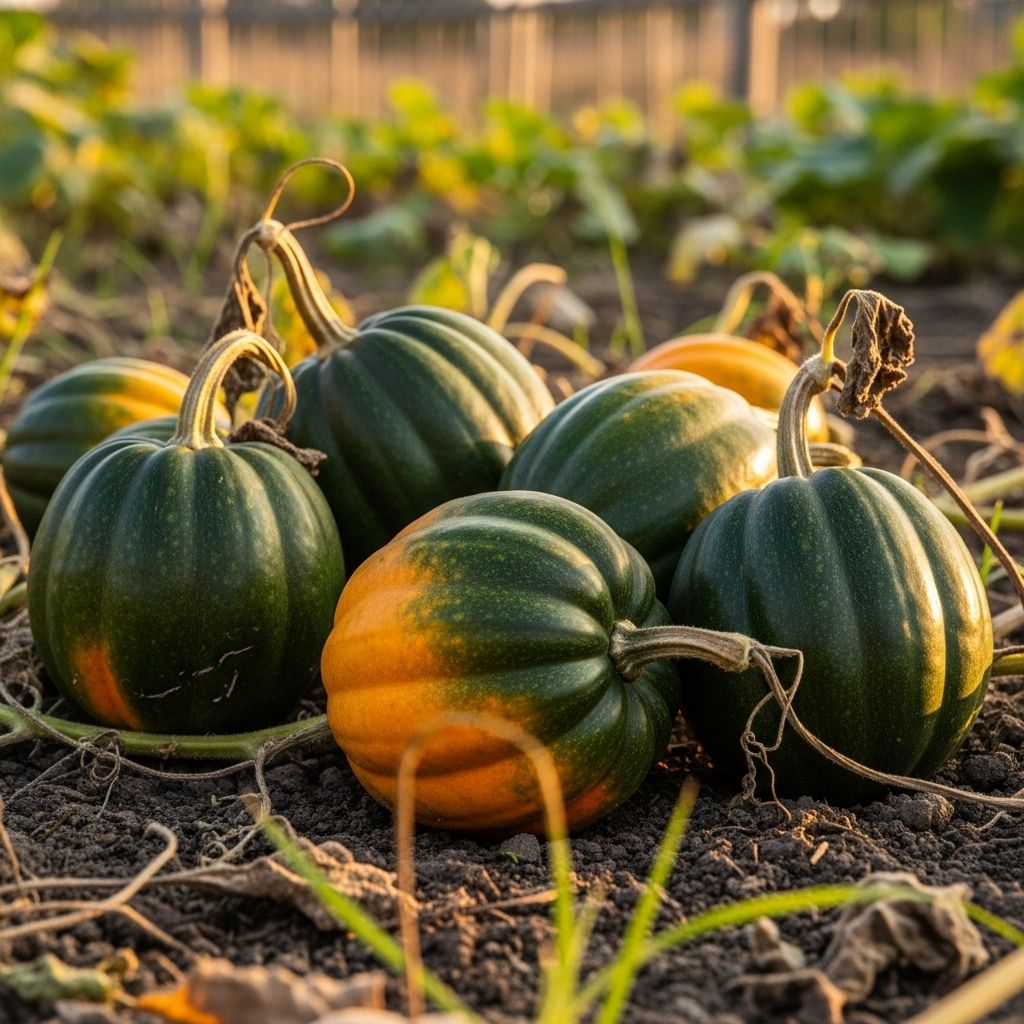When and How to Harvest Acorn Squash Properly
Spotting ripe squash and handling it gently unlocks sweet taste and lasting freshness.

Image: HearthJunction Design Team
Harvesting acorn squash at the right time ensures not only the best flavor and texture but also maximizes storage potential and plant health. This guide breaks down everything you need to know—from identifying ripeness to correct harvesting techniques and tips for prolonging your squash’s storage life.
Understanding Acorn Squash Maturity
Acorn squash (Cucurbita pepo) is a popular winter squash variety that transitions from a tender green to a mature, delicious ingredient suitable for a wide range of dishes. Since acorn squash is frost-sensitive, understanding the signs of proper ripeness before the cold sets in is vital for a successful harvest.
General Timeline for Harvest
- Most acorn squash varieties take 80–100 days from planting to full maturity.
- The exact harvest date can be estimated using the “days to maturity” on your seed packet.
- In most regions, late September to October is harvest time, just before the first heavy frost threatens the vines and fruit.
How to Identify Ripe Acorn Squash
Picking squash too early can lead to poor flavor, while harvesting too late risks overripening and potential spoilage. Use a combination of visual cues and tactile tests to ensure harvest timing is optimal.
Visual Signs of Ripeness
- Color Change: Ripe acorn squash typically has a deep, dark green color on the ribs. The side of the squash that touches the ground develops a spot that turns from pale yellow to deep orange as it matures.
- Stem Condition: The stem of a mature fruit will start to turn brown and become woody. The vine around the squash may also begin to dry and die back.
- Overall Appearance: Size can be misleading since acorn squash often reach near-full size before they are fully ripe. Focus on skin color and stem rather than size alone.
Texture and Skin Tests
- Try pressing your fingernail gently into the squash’s skin. If the skin is tough and resists penetration, the squash is mature. If your nail punctures the skin easily, the fruit is still immature and should be left on the vine longer.
- The skin should feel hard and protective, rather than soft or thin.
Varietal Differences
- Some acorn squash varieties are bred to turn completely orange at maturity. Always check your seed packet for specific harvest cues if planting a less common variety.
The Importance of Timing Your Harvest
Timing is crucial for acorn squash. Unlike summer squash, which can be picked and enjoyed young and tender, acorn squash must mature fully to develop the dense flesh and thick skin needed for winter storage. However, the fruit is very sensitive to cold; exposure to frost can damage both the texture and flavor, significantly shortening storage life.
- Do not wait for frost: Harvest before the first forecasted hard freeze.
- If in doubt, err on the side of slightly under-ripe rather than risking exposure to cold temperatures.
- Acorn squash may continue to ripen a bit after harvest if picked just as they reach maturity.
Step-by-Step Guide: How to Harvest Acorn Squash
- Inspect the Plants: Look for the visual and textural signs described above. Aim for fruits with dark green coloration, a deep orange ground spot, and a browning stem.
- Choose the Right Tools: Use a pair of sharp, sturdy pruners or garden shears. Avoid pulling fruit from the vine by hand as this can damage both the squash and the plant, potentially jeopardizing other developing fruit.
- Cut, Don’t Pull: Cut the squash from the vine, leaving 2–3 inches of stem attached to the fruit. This protects the squash from microbial invasion and prolongs post-harvest storage.
- Handle with Care: Even though acorn squash seem tough, bruising or nicks during harvest can cause spoilage during storage. Carry and set them down gently.
- Trim Vines (if needed): If there are no additional fruit developing on the same vine segment, you can prune the vine back after removing the mature squash to redirect plant energy to any remaining fruit.
Harvesting Acorn Squash Blossoms
Beyond fruit, the blossoms of acorn squash are edible delicacies. However, some caution is needed to prevent reducing your crop:
- Only pick male blossoms, identifiable by their long, thin stems and lack of swelling at the base (unlike female flowers, which have a tiny baby squash beneath the petals).
- Harvest blossoms in the morning, when they are fully open but before they wilt in the midday sun.
- Leave most female blossoms on the plant to maximize fruit development.
Post-Harvest Handling and Curing
Proper handling after harvest is essential for maximizing acorn squash shelf life and taste.
Initial Storage
- Keep the harvested squash in a shaded, well-ventilated area for a few days to let any field heat dissipate. This is especially important if the harvest was on a hot day.
- Do not wash the squash until just before use. Moisture can encourage mold during storage.
Curing Acorn Squash
- Unlike some other winter squash varieties (like pumpkins or butternut), acorn squash do not require a lengthy curing period; their skin is already thick and hard at harvest time.
- If you want to maximize sweetness, allow harvested squash to sit at room temperature for a week before moving them to long-term storage. Some minor starch-to-sugar conversion occurs during this period, enhancing flavor.
Storage Tips for Acorn Squash
- Store in a cool (50–55°F), dry, and well-ventilated location.
- Keep squash off concrete floors and avoid stacking them, which can lead to bruising and spoilage.
- Ideal spots: Pantry shelves, a dry basement, or lightly heated garage. Avoid cold, damp places, which can encourage mold or rot.
- Under optimal conditions, acorn squash can last 1–3 months.
- Discard any squash showing soft spots or mold, as decay can spread quickly to the rest.
Common Mistakes When Harvesting Acorn Squash
- Harvesting too early: Leads to bland taste, watery flesh, and poor storage.
- Waiting too long: Overripe squash often turn completely orange (unless variety specifies otherwise), develop stringy texture, and do not store well.
- Improper handling: Dropping or bruising fruit during harvest can create entry points for decay.
- Removing entire stem: Always leave 2–3 inches attached to protect the fruit from rot.
- Ignoring local frost warnings: Cold-damaged squash have significantly reduced shelf life and flavor.
Quick Reference Table: Signs of Acorn Squash Ripeness
| Indicator | Immature | Ripe |
|---|---|---|
| Color | Bright, lighter green | Dark green, deep orange spot on underside |
| Stem | Green and flexible | Browning/drying, woody |
| Skin Texture | Soft, easily dented by fingernail | Hard, resists denting |
| Vine | Vigorous, green | Drying, dying back near fruit |
| Storage | Poor | Stores 1–3 months |
Additional Tips for an Abundant Harvest
- Stagger planting times if possible to extend the harvest window and avoid a glut all at once.
- Rotate crops annually to minimize pest and disease carryover in the soil.
- Mulch under the vines to reduce ground-spot blemishes and help fruit develop evenly.
- Watch for pests and diseases near harvest, as squash bugs, powdery mildew, and vine borers can impact fruit quality late in the season.
Frequently Asked Questions (FAQs)
Q: What happens if I pick acorn squash too early?
A: Immature squash have thin skin and a bland, watery flavor. They also do not store well and may spoil quickly.
Q: Can I eat acorn squash that is fully orange?
A: In most varieties, squash that is completely orange is overripe and may have a stringy, less desirable texture. However, some varieties are bred to turn orange at maturity, so consult your seed packet to be sure.
Q: How do I know if acorn squash is spoiled after storage?
A: Signs of spoilage include soft or mushy spots, an off smell, visible mold, or liquid seeping from the squash. Discard any fruit showing these symptoms.
Q: Can I store cut or cooked acorn squash?
A: Yes. Cut acorn squash should be kept in the refrigerator and used within a few days. Cooked squash can be refrigerated for 4–5 days or frozen for several months.
Q: Why leave a stem on harvested squash?
A: Leaving 2–3 inches of stem attached prevents fungal and bacterial entry, prolonging storage life and reducing spoilage risk.
Conclusion
Perfecting your acorn squash harvest is less about measuring fruit size and more about recognizing subtle signals from your plants and fruits. Careful observation, gentle handling, and timely harvest are the keys to enjoying flavorful, long-lasting squash from your garden each season. Start watching for color changes, test skin firmness, and act before the first frost—your pantry and your palate will thank you.
References
- https://shop.epicgardening.com/products/table-king-acorn-winter-squash-seeds
- https://www.epicgardening.com/when-to-pick-acorn-squash/
- https://www.epicgardening.com/growing-acorn-squash/
- https://www.pinterest.com/pin/the-best-time-to-harvest-acorn-squash-epic-gardening–520799144423900347/
- https://www.youtube.com/watch?v=PnjaqQZZAJM
Read full bio of Srija Burman












